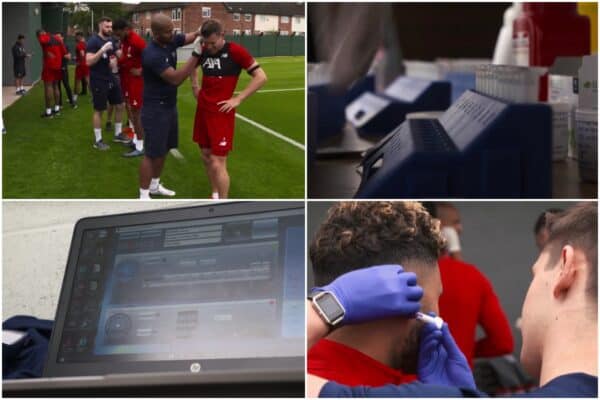Liverpool will soon report back to Kirkby for the first day of pre-season, which typically sees players take the lactate test. But what is the lactate test and how does it work?
Jurgen Klopp welcomes his initial group back for pre-season training on July 12, which will see those not involved in international tournaments put through their paces early on.
The first days of pre-season are allocated for testing the squad’s fitness levels, before ball work is slowly integrated when players are back up to the standard required.
It has become a tradition at Liverpool for the first team to be put through the lactate test on day one, with the endurance exercise dreaded by many within the squad.
So what is the lactate test and why do the Reds do it?
As explained by EKF Diagnostics, who provide some of the equipment needed to implement the lactate test, it is used to “learn the highest intensity at which a footballer can train or compete before hitting the wall from high levels of blood lactate.”
Players are tasked with running around one of the Kirkby pitches at a series of different intervals and paces, with blood tests taken after every interval to test for levels of lactic acid.

If a player is above a certain amount, they will then drop out of the drill, with James Milner typically the last man standing whenever the test is used at Liverpool.
“Once you surpass this threshold, lactic acid will start to build up in your muscles faster than your body can remove it, eventually leading to fatigue,” EKF Diagnostics continues.
“Testing and improving lactate threshold within a training program can be used to make stronger and faster athletes.”
In short, if the pace and intensity a player can manage with their lactate threshold is higher than their opponent, they will be able to last longer at the level required.
This is essential within Klopp’s system, which is not wholly centred around outrunning the opposition – and particularly not now, as their approach has evolved – but still demands the highest level of fitness possible.
Andy Robertson discovered this the hard way when he took his first lactate test as a Liverpool player, with the left-back detailing his experience in an interview with Open Goal in 2018.
“It’s horrible, running round the pitch, I’m doing it with Danny Ings and that,” Robertson recalled.
“My medical went on for two days – it was quite a long medical – so I wasn’t eating, I wasn’t doing this and that. I was fit, because I had three weeks at Hull and I was looking after myself.
“So I’m taking the lactate test and I’m thinking, ‘my stomach’s a bit dodgy here’. I started gagging and I was sick everywhere.
“Halfway around I had to stop and be sick, then I tried to catch them up because I’m thinking, ‘I can’t drop out at this point’, because this point was like you are super unfit, that was the point you had to get by.

“So I was sick around the pitch, then I had to stop because they have to take the blood out your ear, and I was sick when I was getting my blood taken.
“I went another lap and I was like ‘I need to stop’.”
Fortunately, Robertson was eventually able to prove himself to Klopp and now has a reputation as not only one of the fittest players at Liverpool, but also in the Premier League.
While the lactate test is not unique to Liverpool, it is another example of the marginal gains enjoyed by the club.
That will remain the case on July 12 when the Reds are put through the test again.

















Fan Comments